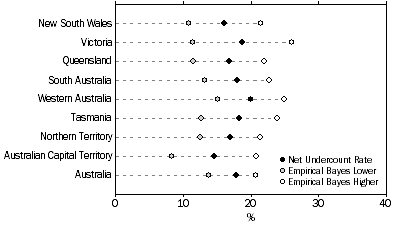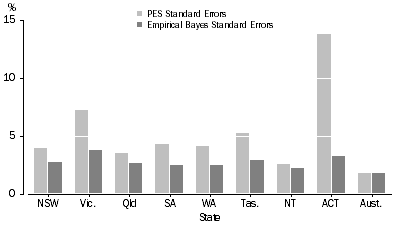FEATURE ARTICLE 2: METHODOLOGY USED TO PRODUCE PRELIMINARY ABORIGINAL AND TORRES STRAIT ISLANDER POPULATION ESTIMATES
INTRODUCTION
The Australian Bureau of Statistics (ABS) compiled preliminary rebased estimates of the Aboriginal and Torres Strait Islander Population based on the 2011 Census of Population and Housing and Post Enumeration Survey (PES) results. This Feature Article describes the method used to compile these estimates.
THE CENSUS POST ENUMERATION SURVEY
While every effort is made to ensure full coverage of people and dwellings in Australia in the Census, a small number of people will inevitably be missed, while others will have been counted more than once. In Australia more people are missed than are counted more than once. The net effect of overcount and undercount is called net undercount.
To measure net undercount of the Australian population, the ABS conducts the PES shortly after the Census. The PES is a sample survey that provides an independent check of Census coverage. In 2011, the survey had a sample of over 42,000 dwellings, with around 36,000 dwellings responding. Respondent information collected in the PES is linked with corresponding Census information to determine whether each resident of the PES household was counted in the Census, missed or counted more than once. The PES also provides information about the consistency of data across the two collections.
Net Undercount
The preliminary estimate of the Aboriginal and Torres Strait Islander population at the time of the 2011 Census derived from PES was 662,000 people. This is 114,000 people more than the Census count for Australia (excluding Other Territories) of 548,000 Aboriginal and Torres Strait Islander people. This Census count of Aboriginal and Torres Strait Islander people excludes people whose Indigenous status was unknown in the Census. The Aboriginal and Torres Strait Islander net undercount (the difference between the PES Aboriginal and Torres Strait Islander population estimate and the Aboriginal and Torres Strait Islander population Census count) was 114,000 people.
The ABS undertook an additional and extensive quality assurance process for the PES to understand the components of Aboriginal and Torres Strait Islander net undercount in 2011. This process identified that the main explanatory factor behind an increase in net undercount from 2006 was the improved PES methodology and procedures, which led to better identification of Aboriginal and Torres Strait Islander persons in the 2011 PES. This is explored in further detail in Census of Population and Housing - Details of Undercount, 2011 (cat. no. 2940.0).
UNKNOWN INDIGENOUS STATUS - IMPUTATION
There were 1,059,000 Census records (4.9% of the total Census count) with Indigenous status unknown in the 2011 Census. Of these, 27% (or 1.3% of the total Census count) were a result of item non-response; that is, the ABS received a partially completed Census form for the person with the Indigenous status question unanswered. The remaining and majority (73%) of records with unknown Indigenous status (3.5% of the total Census count) were a result of imputation by the ABS for people who were identified as resident in dwellings (both private and non-private) at the time of the Census but for whom no Census form was received. While some of the records with unknown Indigenous status will be for people of Aboriginal and/or Torres Strait Islander origin and other for non-Indigenous people, no imputation was made for Indigenous status for these records in the Census dataset.
In order to provide estimates of the Aboriginal and Torres Strait Islander population, it is necessary for the PES to apply a treatment for records with unknown Indigenous status. Not stated Indigenous statuses are allocated to be either Aboriginal and Torres Strait Islander or non-Indigenous, according to the distribution of stated responses within each age group, sex, Census form type and geographical area (Statistical Area Level 2).
CALCULATING PRELIMINARY ESTIMATED RESIDENT POPULATION
The estimated resident population (ERP) for Australia and the states and territories is compiled using the Census, PES and other demographic information (see below).
The Census provides detailed information on the age and sex structure and location of the population, but the PES is limited in its ability to provide detailed information for people missed in the Census.
Preliminary PES estimates of net undercount for Aboriginal and Torres Strait Islander persons in the 2011 Census were calculated at the national level and for 18 regions. The states of Victoria, Tasmania and South Australia, along with the Northern Territory, were separated into two regions (split between capital city and balance of state), while New South Wales, Queensland and Western Australia were separated into three regions (with the balance of state split). The Australian Capital Territory was considered to be a single region. Each of these regions was a customised geographic area designed to capture the varied collection issues in different parts of Australia, as an input into the Empirical Bayesian estimation method.
Empirical Bayes Estimation
The Empirical Bayes method takes the original PES estimate of the undercount adjustment rate (the ratio of the PES population estimate to the Census count) for each region and smooths this towards a prediction based on the Census characteristics of the region (specifically the proportion of Aboriginal and Torres Strait Islander persons and the level of Census non-response in the region).
The Empirical Bayes method used for the 2011 estimates was the same as used in 2006, except for some minor changes, including the use of 18 regions (up from 15 in 2006).
The overall amount of smoothing used in each region was determined by two factors: the standard error for each region and an overall smoothing constant. The smoothing constant was chosen using the 'method of moments' technique developed by Morris (1983). The aim of smoothing is to provide stable estimates with lower standard errors. Regions with high standard errors required more smoothing and hence received a greater proportion of the national PES estimate, while regions with lower standard errors received a greater proportion of their individual PES estimate. The outcome of this methodology, in relation to smaller standard errors and confidence intervals, is presented in the table and graphs below.
Empirical Bayes Estimates and Standard Errors |
|
 | EB Population Estimate | EB Undercount | SE | EB Undercount rate | SE |
| State | no. | no. | no. | % | % |
|
| New South Wales | 205 762 | 33 147 | 6 743 | 16.11 | 2.72 |
| Victoria | 46 726 | 8 739 | 2 115 | 18.70 | 3.73 |
| Queensland | 187 223 | 31 402 | 6 022 | 16.77 | 2.67 |
| South Australia | 37 096 | 6 664 | 1 092 | 17.96 | 2.43 |
| Western Australia | 87 104 | 17 440 | 2 673 | 20.02 | 2.52 |
| Tasmania | 24 001 | 4 381 | 832 | 18.25 | 2.86 |
| Northern Territory | 68 346 | 11 561 | 1 849 | 16.91 | 2.24 |
| Australian Capital Territory | 6 068 | 884 | 233 | 14.57 | 3.21 |
| Australia | 662 326 | 114 218 | 14 274 | 17.24 | 1.78 |
|
95% Confidence intervals on the net undercount rate, Empirical Bayes Method

Comparison between PES and Empirical Bayes Standard Errors

Estimates of the Aboriginal and Torres Strait Islander (and non-Indigenous) population were then adjusted to include Australian residents temporarily overseas at the time of the Census (9 August 2011) and also backdated to the estimated resident population reference date of 30 June 2011 using data on births, deaths, and interstate and overseas migration. Estimates were also assumed for net undercount in Other Territories, which were added to the Census count of Aboriginal and Torres Strait Islanders people identified as being usual residents in those territories (around 8,000 persons).
Age Heaping in the Northern Territory
The age structure of the Aboriginal and Torres Strait Islander population estimates of the Northern Territory has some noticeable population spikes at ages ending with "0" and "5". This phenomenon is known as "age heaping" (or digit preference) and is a relatively common demographic issue in populations worldwide.
In this publication, the ABS has released the Northern Territory's Aboriginal and Torres Strait Islander population estimates aggregated to five year age groups and, as such, age heaping is not evident. The ABS has investigated a number of options for addressing age heaping in the Northern Territory and has concluded that a treatment should be applied for final rebased estimates. The ABS welcomes feedback on this matter before the publication of final estimates in 2013.
PLANS FOR FURTHER OUTPUT
Final resident population estimates by Indigenous status will be available in August 2013 in the publication
Estimates of Aboriginal and Torres Strait Islander Australians (cat. no. 3238.0.55.001). For more information regarding preliminary estimates of Aboriginal and Torres Strait Islander population please contact Shahidullah on (02) 6252 6487, Nick McTurk on (02) 6252 5411, or email demography@abs.gov.au.
 Print Page
Print Page
 Print All
Print All
 Quality Declaration
Quality Declaration